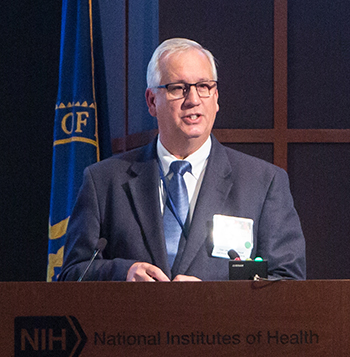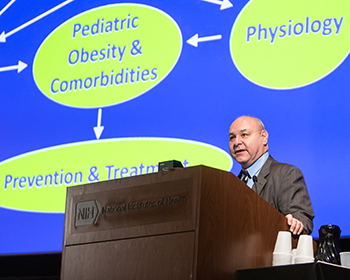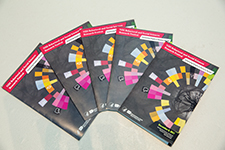Behavioral and Social Sciences Research Festival 2017
Charting New Paths
“These days, we once again see behavioral science at the forefront of health research,” said NIH Principal Deputy Director Lawrence Tabak during the opening remarks of the NIH Behavioral and Social Sciences Research Festival, held in December. Behavioral and social sciences are “charting new paths in [mobile] health [and] disease monitoring, reducing tobacco use, lowering sudden-infant death, [and] preventing diabetes.” Tabak went on to discuss the importance of behavioral and social sciences in combating the crisis of opioid abuse that is gripping our nation. “Without the behavioral and social sciences overlay, those pharmaceutical [treatments for opioid abuse] don’t matter,” Tabak stressed. “If the patient doesn’t take advantage of them, if the prescribers don’t think through what they are doing, none of this will matter.”

PHOTO BY CHIA-CHI CHARLIE CHANG
Nearly every institute is supporting behavioral and social science research, OBSSR Associate Director William Riley noted during his remarks at the festival.
After Tabak’s remarks, NIH Associate Director for Behavioral and Social Sciences Research William Riley discussed the state of the behavioral and social sciences at NIH in fiscal year 2017 (FY17), noting a steady increase in funding from FY15 to FY17 with nearly every institute supporting behavioral and social science research. Riley then addressed OBSSR’s co-funding initiative—approximately $20 million annually—which supports meritorious intramural and extramural research from all NIH institutes and centers. In 2017, OBSSR funded 123 grants.
For the first time, this year’s Research Festival highlighted some intramural research. Jack Yanovski, chief of NICHD’s Section on Growth and Obesity, presented “Depression and Insulin Resistance in Adolescent Girls—an Intramural NIH Bench-to-Bedside Investigation,” in which he presented several studies that investigated the link between depression and insulin resistance in adolescent girls at risk for developing both type 2 diabetes and depression. Using their 15-year prospective, longitudinal study, Yanovski’s lab found that early symptoms of depression predicted greater insulin resistance at follow-up visits. He also found that successful treatment of depression with cognitive-behavioral therapy led to a significant reduction in insulin concentrations. Ongoing studies are assessing the mechanisms that underlie depression-induced insulin resistance in adolescent women. (L.B. Shoemaker, N.R. Kelly, R.M. Radin, et al., “Prevention of insulin resistance in adolescents at risk for type 2 diabetes with depressive symptoms: One-year follow-up of a randomized trial,” Depress Anxiety 34:866–876, 2017; DOI:10.1002/da.22617)

PHOTO BY CHIA-CHI CHARLIE CHANG
Jack Yanovski, chief of NICHD’s Section on Growth and Obesity, presented several studies that investigated the link between depression and insulin resistance in adolescent girls at risk for developing both type 2 diabetes and depression.
Another new feature of the 2017 Research Festival was the NIH Institute Perspective, provided this year by Eliseo Pérez-Stable, director of the National Institute on Minority Health Disparities (NIMHD). One of the NIMHD-supported research projects is the first U.S. national study that assessed the impact of direct-mail marketing on smoking behaviors. The study, conducted by NIMHD Earl Stadtman Investigator Kelvin Choi (in collaboration with researchers at two universities), found that tobacco company marketing strategies—specifically, distribution of direct-mail coupons—were disproportionately targeting low-income individuals with limited educations. The strategies were associated with recruiting new smokers and the continuation of smoking among current smokers (Nicotine Tob Res ntx141; DOI:10.1093/ntr/ntx141). Pérez-Stable hopes that the NIMHD’s intramural research program will address research gaps such as few studies investigating the provider-patient relationship.
The one-day festival also featured three panel discussions. The first panel described findings from studies of behavioral interventions. Eric Lenze (Washington University School of Medicine, St. Louis, Missouri) talked about how he effectively used mindfulness techniques to improve memory and prevent dementia among elderly individuals, all of whom continued their mindfulness practice after the study ended.
Sebastian Linnemayr (RAND Corporation, Arlington, Virginia) found that small economic incentives, including participation in a low-stakes lottery or a competition with peers, could improve adherence to anti-retroviral medication among Ugandans with human immunodeficiency virus.
Kelli Komro (Rollins School of Public Health, Emory University, Atlanta) performed both an individual and a community-based intervention to prevent alcohol abuse in white and Native American teens. Both interventions were successful.

PHOTO BY CHIA-CHI CHARLIE CHANG
The second panel emphasized behavioral neuroscience research. Paul Kenny (Icahn School of Medicine at Mount Sinai, New York) noted that “like most things, there’s a yang to that yin” and depending on which dose you use, “drugs are perhaps as adverse as they are rewarding.” Kenny probed nicotine intake and avoidance behaviors and found that nicotine intake was reduced by glucagon-like peptide-1, a hormone known to decrease blood sugar.
Shannon Gourley’s (Emory School of Medicine, Atlanta) research involved using operant conditioning to examine cocaine-induced changes in decision-making among adolescents. Her findings suggest that the receptor for brain-derived neurotrophic factor, tropomyosin receptor kinase B, may be a useful therapeutic target.
Russell Fernald (Stanford University, Stanford, California) described his research that showed a direct effect of social rank on the growth and development of the brain, gonads, and physical appearance of cichlid fish (species of the family Cichlidae).
The final panel on “Social Factors and Health” featured discussions on the opioid crisis, social stress on people as they age, and how health disparities are a problem of child development.
“Anyone who is paying any attention can see that there’s something bigger than drugs going on,” warned Shannon Monnat (Syracuse University, Syracuse, New York). “[Opioids] are the current canary in the coal mine,” but a larger “despair crisis”–rising mortality from drugs, alcohol, and suicide–is plaguing economically distressed parts of rural America. “Until we start dealing with those issues, we’re going to be in big trouble,” she said.

PHOTO BY CHIA-CHI CHARLIE CHANG
The festival also included a poster session and two town hall meetings (one for NIH staff, another for the extramural community) during which participants brainstormed ways to improve collaboration among behavioral and social science researchers.
Yang Claire Yang (University of North Carolina at Chapel Hill, Chapel Hill, North Carolina), discussed the effects of social stress on individuals as they age.
In his presentation, Stephen Gilman (NICHD) described his investigations into whether social and economic hardship disrupts maternal immune activity during pregnancy and, if so, whether there are implications for offspring neurodevelopment. He assessed biological samples and socioeconomic, psychological, and developmental data gathered from nearly 1,500 women—and their children—enrolled in the New England Family Study cohorts of the Collaborative Perinatal Project. He found that greater maternal socioeconomic disadvantage was tied to higher rates of neurodevelopmental abnormalities in their offspring. The findings suggest these abnormalities were mediated by activation of the immune system during pregnancy (Proc Natl Acad Sci U S A 114:6728–6733, 2017; DOI:10.1073/pnas.1617698114).
The festival also included a poster session and two town hall meetings (one for NIH staff, another for the extramural community) during which participants brainstormed ways to improve collaboration among behavioral and social science researchers. The day reflected the rich and diverse nature of the behavioral and social sciences supported by the NIH, from basic behavioral neuroscience studies to applied behavioral interventions and social determinants of health.
The festival, held on December 8, 2017, was hosted by the NIH Behavioral and Social Sciences Research Coordinating Committee and the Office of Behavioral and Social Sciences Research. To watch a videocast, go to https://videocast.nih.gov/launch.asp?23630.
This page was last updated on Friday, April 8, 2022
